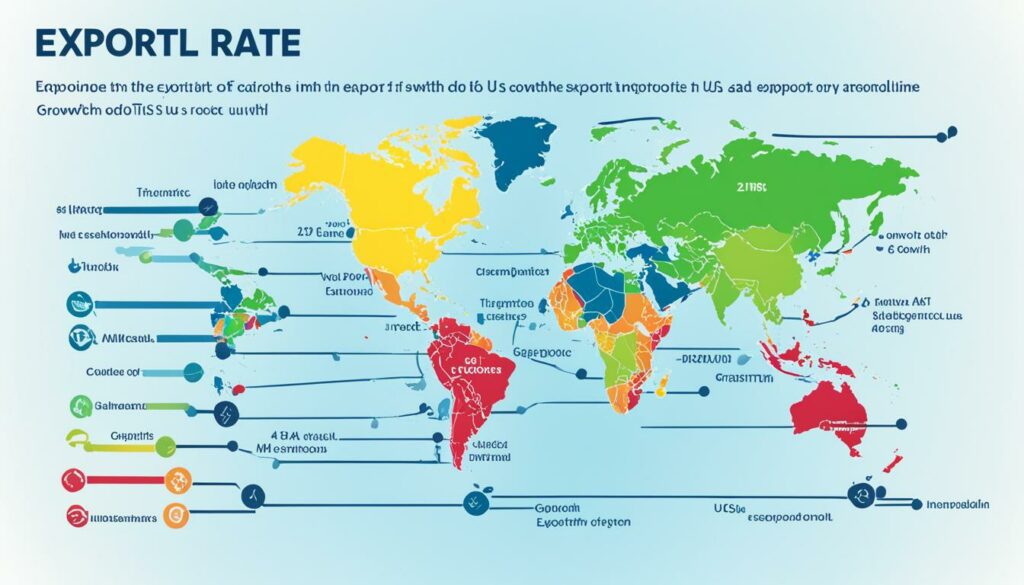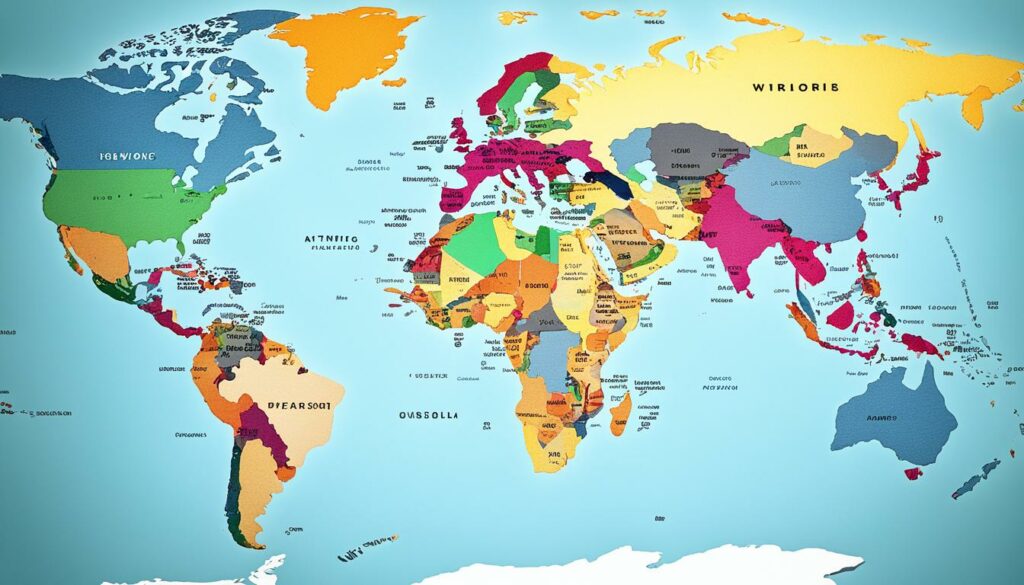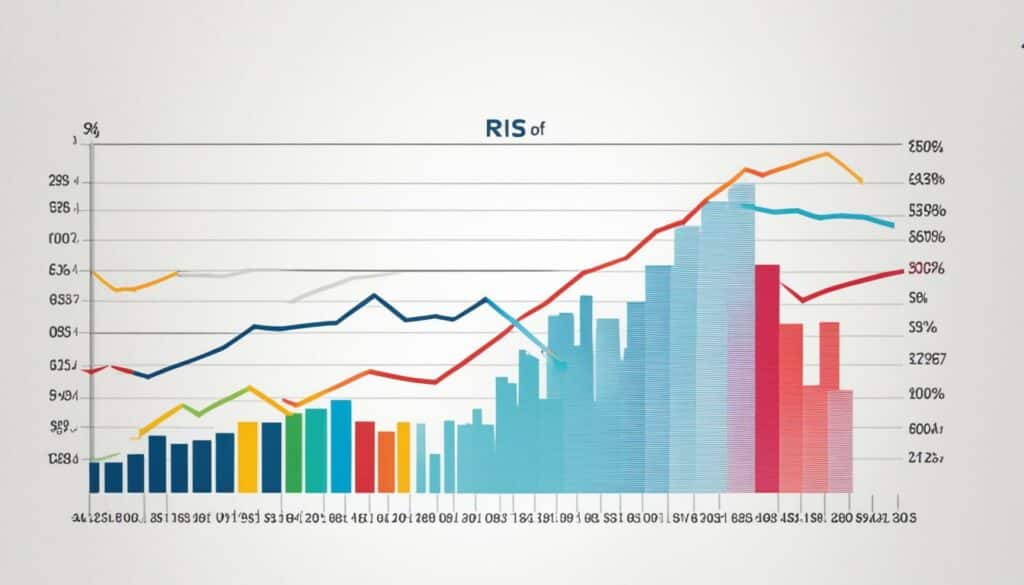Menu

The U.S. Commercial Service connects with an incredible 97% of customers around the world. This shows how vast the opportunity is for U.S. businesses globally. Even though the U.S. makes up less than 5% of the world’s population, it earns over 20% of the total income. This makes America very important worldwide.
The United States leads the world in economy and trade because of efforts made after World War II. These efforts have lifted American incomes by 9% in 2013, totalling a staggering $1.5 trillion. With most of the money spent worldwide and many consumers abroad, the U.S. has a lot to gain from expanding its trade.
If global trade barriers vanish, these benefits could jump up by 50%. This would further prove how crucial trade is for economic and job growth recovery. For Americans trading globally, knowing about export market intelligence and export opportunities is crucial to keep up with global market trends.
The United States sees international trade as key for growth and wealth. The data shows that smart trade policies boost American businesses. These policies help grow the U.S. economy.
Opening up trade has let U.S. businesses grow. This helps create more jobs and gives people more money. Big investments in making and selling goods abroad have really helped the U.S. economy.
In fact, from 2009 to 2014, a third of the U.S.’s economic growth came from selling goods overseas. The country exported lots during that time. This shows why global trade is so important to America.
American trade policies go back a long way, especially since the early 1900s. After World War II, these policies helped boost people’s real incomes and grew the market for American goods. As we see in 2022, the world relies heavily on U.S. exports.
The U.S. alone exported loads of cars in 2022, showing its big role in global trade. Economic forecasts stress the importance of keeping trade open to grow further.
Looking at the data, it’s clear that export deals have been vital. They help bring in goods the U.S. needs and boost its own sales. Trade rules have really helped the U.S. economy rise. They will continue to do so in the future.
Finding out about the latest export market trends helps U.S. traders. They can use market analysis reports to see where their products might do well. Knowing this, they can focus on areas and industries with the best chances of success.

In March 2024, the U.S. trade deficit in goods and services decreased to $69.4 billion. Yet, the goods deficit rose to $92.5 billion, while services saw a surplus of $23.1 billion. Key markets driving U.S. exports can be seen in the table below:
| Market | Key Trends | Opportunities |
|---|---|---|
| China | US imports decreased by 7.2 percentage points (2017-2023) | Shift focus to higher value services |
| Mexico, Vietnam, Taiwan, India | Increased US goods imports by 5.1 percentage points | Leverage regional trade agreements |
| Japan | China’s import share dropped by 1.6 percentage points (2019-2023) | Increase agricultural and tech exports |
U.S. exports have a big future in emerging markets. Their PMI was 52.7 in August, showing growth is strong. But, developed markets’ PMI fell, making the shift to these new markets more likely. Here’s what businesses should know:
Through careful study of export trends and using market reports, U.S. businesses can find great opportunities in global markets. This can help them grow their reach and profits.
US exports greatly boost the country’s wealth, making a big mark on the GDP and creating jobs. Research and development (R&D) is key. In 2021, it was responsible for 2.3 percent of the US economy. This shows how crucial it is to keep investing in new ideas and technologies for economic gains.
Exports are fundamental for the US economy. They significantly affect the GDP. The GDP formula clearly shows the importance of exports. They have been a big source of GDP growth, about 2.3 percent each year since 2009. This highlights the ongoing benefit of global trade for economic health.
Exports play a huge role in creating jobs. The years between 2009 and 2013 saw a big jump in jobs related to exports. They increased by 1.6 million, reaching about 11.3 million. This growth benefitted many states, such as New Mexico, which saw 6.3 percent of its GDP from R&D. Agricultural exports are also vital, helping local businesses and supporting other industries. It proves the essential role exports play in the US economy.
In March 2024, the US faced a trade deficit of $69.4 billion. But, there was good news too. The surplus in services increased by $0.9 billion to $23.1 billion. This shows a strong service sector. Consumer spending also rose by $160.9 billion, showing the positive impact of trade on the economy.
Ninety-seven percent of the world’s customers are not in the United States. This makes the global market a key area for American businesses to explore. Important strategic thinking is needed to make the most of this market.

Starting with in-depth market research studies is key. Diving into tools such as the Market Diversification Tool helps understand where the demand is. Personalised studies reveal the exact needs and buying power in different markets.
Whitworths, for example, worked with Bolst Global in 2019 on a strategy for going international. This highlights how unique studies are important for success in new territories.
Knowing the competition is just as vital. It means studying what your rivals sell, how much they charge, and where they stand in the market. This knowledge shapes a company’s approach to exporting. Using systems like the Harmonized System (HS) Codes and following Incoterms® makes operations smoother.
By utilising strategic planning and detailed research, American companies can make their international moves more efficient. This way, they can lower costs and use less time while reaching more markets.
Navigating international markets needs good tools and info. The U.S. Commercial Service helps businesses reach 97% of the world’s customers.
Country Commercial Guides are key. They’re from U.S. Embassies and they give deep market insights. With these guides, businesses can understand market needs and use Free Trade Agreements to grow.
Trade Stats Express shows detailed U.S. export numbers. It helps find growing markets and important trends. This info is gold for building export plans and finding good business chances.
It also has tools for everyday export tasks and growing sales. It covers export rules and advice for selling online. This keeps businesses ahead in the digital world.
Trade Stats Express also includes HS Codes for product classification. And lists for checking business partners. This helps meet global standards and trust market reports. Taking part in trade events and export programs can create new growth paths too.
Knowing how to use these tools is vital. The U.S. Commercial Service is a big help. It supports U.S. businesses in taking on new markets and growing worldwide.
In global trade, knowing about export market insights is vital for US businesses. This info helps traders understand each industry better. It lets them make smart moves in the world market.

To find out the best sectors, analysts look at economic forecasts and trends closely. Areas like aerospace, cars, and farming are often strong. This strength comes from lots of global need and good trading rules. Keeping an eye on export market insights helps traders quickly adapt.
Every sector has its own ups and downs. It’s crucial to know these through solid industry research. Some areas might be hard to get into, with tough rules. But, by getting this knowledge early, traders can plan smart. This helps them avoid risks and grab chances.
Looking at what rivals are doing and seeing what people really want also matters. With good export market insights, American traders can confidently seek growth. They can do it in a way that’s well-thought-out and bold.
Free Trade Agreements (FTAs) play a big role in global trade. The United States now has 14 FTAs with 20 countries. These deals help lower trade barriers, protect U.S. interests, and improve laws in partner nations.
FTAs make trading easier between countries for many reasons. Primarily, they get rid of or reduce tariffs on certain goods. This makes American goods cheaper and more attractive in other countries. These deals also protect American intellectual property rights.
| Country | Year Implemented | Major Benefits |
|---|---|---|
| Canada | 1989 | Zero or reduced tariffs, increased export benefits |
| Australia | 2005 | Enhanced investment opportunities, IP protections |
| South Korea | 2012 | Reduced barriers to exports, boosted service sector |
Making the most of FTAs is key for American businesses. These pacts help set up standard rules for products. They also let American companies bid on contracts in other countries. Plus, U.S. investors are treated fairly under these agreements.
Trade between Canada and the U.S. grew significantly in 2021. Canada’s exports to the U.S. were up by 23.9%. And its imports from the U.S. increased by 9.7%. This shows the big benefits of good FTAs.
Using FTAs well can make a big difference for businesses. It gives them more chances to sell products overseas. And it can help grow their businesses.
The American farming sector has always been key in export trade. In 2021, it hit record highs, proving the strength in world markets. US farm exports grew by 18%, reaching $177 billion in sales worldwide. This jump helped not just at home but also created jobs for 1.3 million people. It shows how important farm exports are for the economy.

The success story of 2021 shows the vital role of knowing the export market well. The Market Access Program (MAP) and the Foreign Market Development (FMD) program were crucial. They matched private money with government support to boost income and jobs in farming. This way, these government efforts really paid off.
| Year | Value of Agricultural Exports | Economic Activity Generated | Jobs Supported |
|---|---|---|---|
| 2016 | $137.4 billion | $172.1 billion | 1.1 million |
| 2021 | $177 billion | – | 1.3 million |
In 2021, China bought the most farm products from the USA. This trend follows the global demand scene. Mexico and Canada also play huge roles, showing how vital close relations and nearby markets are. Knowing the market well helps in spotting and grabbing the best chances.
The U.S. farming export success is a strong message about its power and future prospects. By smart planning and using what we know about the market, the farm sector can keep growing and helping the economy.
To do well in global markets, one must keep up with economic and political changes. Exporters who regularly read market analysis reports are able to adjust their plans as needed. Being adaptable is key to a successful export business.
Changes in the economy or politics can deeply impact the markets. This can change what people want to buy and how much it costs to sell there. For instance, new rules and shifts in trading paths might happen. That’s why it’s important to keep an eye on global market trends and updates.
Handling market ups and downs requires good planning. Start by picking 3 to 5 export markets and considering all the costs involved. Create a detailed export plan suited to your business. Also, looking at what other countries are importing can help spot opportunities.
Having a strong export plan is crucial for growing internationally. For this, using detailed industry research is a must. It helps you understand your market’s special needs. This approach lowers risks and helps you spot chances to grow.
| Key Strategies | Description |
|---|---|
| Market Selection | Identify fast-growing and largest markets through thorough research. |
| Cost Analysis | Include shipping costs, tariffs, and overall landed costs in your export plan. |
| Primary Market Research | Collect direct data via interviews and surveys to understand market trends. |
| Foreign Import Statistics | Utilise statistics to gauge product demand and adjust strategies. |
| Industry-Specific Insights | Conduct tailored research to gather relevant market insights. |
By adapting to market changes, US exporters can improve their plans and do better globally.
It’s crucial for businesses to understand upcoming US export market changes. They can do this by looking at economic forecasts and watching market trends. This gives them the edge by knowing what potential demand shifts and new export chances might come up. By being prepared, businesses can grow and succeed in a fast-paced global market.

The US has a key role in the world economy, even with a small population share. Efforts to open trade made American real incomes jump by 9% since World War II. In 2013, this meant an extra $1.5 trillion. If all trade barriers are removed, the gains could be boosted by 50%, creating huge export chances.
Extending to non-US markets offers great opportunity for American businesses. From 2009 to 2014, US economy growth was supported by exports. This growth means more jobs, with 1.6 million new positions related to exports by 2013.
Looking ahead, business experts highlight ‘growing demand in key markets’ and ‘expansion into new markets’ as big export growth drivers for 2023. When companies go global, they tend to be 20% more productive and grow twice as fast as those focusing on just national trade.
Nearly 80% of exporters find customers online, making digital channels important for trade. But by 2023, experts expect that advanced automation will become even more vital. Soon, technology like 3D printing and artificial intelligence will likely change how exports work. So, companies need to understand export markets and customer needs well to make the most of these new technologies.
| Key Statistic | Impact |
|---|---|
| US share of world income | Over 20% |
| Increase in real income due to trade liberalisation | 9% ($1.5 trillion in 2013) |
| Potential increase with removal of trade barriers | 50% |
| Contribution of exports to GDP growth (2009-2014) | One-third of 2.3% annually |
| Job increase from exports (2009-2013) | 1.6 million (totaling 11.3 million in 2013) |
By using these insights wisely, businesses can take advantage of new export opportunities. This keeps them strong in an ever-changing market.
Innovation is key in staying ahead in export markets. Market research and analysis reveal chances for innovation. This makes my products stand out. Using the latest tech and understanding what consumers want through research is vital for success.
Innovation must aim to solve problems or create strong feelings. This makes my brand memorable. Research showed that firms in Georgia that focused on innovation also did well in exports.
Finding unmet needs and new markets is crucial for success. Research helps make products that customers really want. Quality is also essential for products to do well in export markets.
Georgia’s economy grew rapidly by investing in innovation. It’s clear that innovation boosts export success. Yet, Georgia could do even better by investing more in innovation.
Making a strong brand with good stories and appealing packaging is key. It helps win customer loyalty. Knowing about global regulations and how to sell your product effectively is also important.
Being eco-friendly is not only good for the planet but also for business. Consumers now prefer sustainable products. Using data to improve and innovate can give a big advantage in trade.
| Indicator | Ranking |
|---|---|
| Global Innovation Index (2016) | 64th |
| Innovations Capacity Index (2015) | 73rd |
| Global Competitiveness Index (Innovation Capacity) | 105th |
| Company Spending on R&D | 123rd |
| Latest Technologies Availability | 111th |
| Protection of Intellectual Property | 99th |
Being successful in global markets requires smart export strategies. For U.S. traders, this means careful planning with a strong export plan and specific market approaches.
A good export plan is key for businesses that want to sell abroad. It must have detailed market analysis, clear goals, and strategies that fit the needs of each market. Smaller companies, who sell across many countries but have few staff, need detailed plans. These plans should include how their products will change for different markets, any special permissions they need, how they’ll promote their products, and their pricing. Knowing the rules and what the local people like ensures a good fit with each market.

Introducing your products into new markets is a big step. While 59% of U.S. traders sell in just one market, mainly Canada, expanding your market efforts can boost your business. A new trend shows that small businesses can successfully sell in many different countries.
Key considerations for effective market entry include:
Direct or indirect selling, with a good and flexible plan, will lead to long-term export success.
Global markets are always changing. It’s key for businesses to know about trade barriers. These can be tariffs, quotas, and rules which make it hard for US companies to export. Knowing about these helps businesses looking to sell overseas.
One of the first things to do is learn about trade barriers. Take tariffs, for example. They might be a fixed amount, like $15 for each pair of shoes brought into a country. Or they could be based on a percentage of the good’s value, such as 15% on cars in Japan from the US. There are also many other barriers like needing a special licence, limits on how much of a product can be imported, or even rules saying some products must be made in the country they are sold. Here’s an overview:
| Type of Trade Barrier | Example | Impact |
|---|---|---|
| Specific Tariffs | $15 tariff on each pair of shoes | Increased costs for importers and consumers |
| Ad Valorem Tariffs | 15% tariff on U.S. automobiles in Japan | Higher prices for imported goods |
| Import Quotas | Volume limit on citrus fruit | Restricted supply and increased prices |
| Voluntary Export Restraints | Export limits set by exporting countries | Reduced competition and higher prices |
| Local Content Requirements | Mandate for a percentage of goods to be produced locally | Challenges in supply chain and increased costs |
Beating export problems takes careful planning. One way is to push for rules that make trade easier. Free Trade Agreements (FTAs) can help with tariffs. Companies might also need to change their products to meet certain standards in other countries. This can make selling abroad easier. Watching the latest international trade news helps businesses get ready for and deal with trade barriers. This way, they can sell more overseas.
Today, technology is key for growing export markets. It’s important for businesses to use digital tools and data analytics. These help improve market research, make operations smoother, and support decisions.

Companies can do detailed market research thanks to digital tools. They offer real-time insight and tracking. This is great for making smart decisions. By using these tools, businesses can boost their logistics, better customer service, and work more efficiently.
Data analytics and business tools help companies understand market trends and what customers like. This knowledge reduces risks and helps follow trade rules. With this info, a company can match strategies to what the market wants. This boosts their chance to sell more abroad.
Also, using software and digital platforms can avoid fines and bad reputation by managing risks well. Tools for working together and communicating improve partnerships in global trade. They make relationships better among people involved in importing and exporting.
Technology isn’t just handy. It’s a key strategy for making export markets better and bigger.
In international trade, cultural understanding is key. Exporters must recognise and adapt to local customs. This helps in navigating through different cultural orientations.
Whether it’s the high-context cultures of Asia, the Middle East, Latin America, and Africa, or the low-context cultures in places like Australia, knowing how locals think and act is critical.
Understanding communication styles and decision-making is, therefore, essential. It can make the difference between a successful business deal and a missed opportunity.
Different societies have their unique ways of managing time, sharing stories, and viewing personal space. Australia, for example, uses time simply and directly. This differs from places like the Middle East and Latin America, where events aren’t strictly scheduled.
In business environments, Australians value equality and their own space. But in India and China, people comfortably stand close when talking. Adapting to these cultural preferences helps businesses better connect with local communities.
| Country/Region | Context Culture | Time Management | Business Culture |
|---|---|---|---|
| Australia | Low-context | Monochronic | Egalitarian |
| Middle East | High-context | Polychronic | Hierarchy-based |
| Latin America | High-context | Polychronic | Hierarchy-based |
| India | High-context | Polychronic | Hierarchical |
| China | High-context | Polychronic | Hierarchical |
In export markets, building strong international relationships is crucial. It relies on mutual respect and understanding of each other’s culture. This leads to smoother business discussions and better working relationships.
For Australians, forming trustworthy, long-lasting international ties is vital. A background of living abroad, working in multinational companies, or studying in foreign countries can be a big plus. This extra cultural insight improves business interactions and smart decisions.
Looking back on all we’ve learned, it’s crystal clear: strong market insights are key to global success. We use U.S. export stats and foreign import data to measure market size and spot good opportunities. It’s crucial to do both primary and secondary market research. This helps us really understand a market, looking at things like how many people live there and income levels. Plus, what our competitors are selling.
Good planning is critical after we find these insights. A well-thought-out export plan for each market is a smart move. This means we focus on places with potential, considering factors like who else is selling similar things. If we aim at three to five markets and start with the top two or three, we’ll work more efficiently. Detailed plans also help us face challenges, like high tariffs. They make our products stand out by including all costs, from packaging to marketing.
At the end of the day, success in exporting is all about smart, data-led strategies and knowing global market trends. Using U.S. export info and tailored research brings big benefits. In today’s fast-changing world, testing the waters in foreign markets with affordable online and offline tools is a must. By sticking to these solid strategies, U.S. traders could be leaders in global trade. This happens when they plan well and stay ahead of the game.
Export market expansion is key for US traders. It boosts the economy and creates jobs. Businesses can grow by selling their products internationally. This keeps them strong in the world market.
Since World War II, US trade policies have become more open. This has helped the country to grow economically. It means more money for people, fewer barriers to trade, and better export strategies.
Emerging markets, changing consumer needs, and a focus on green products are big now. Knowing these trends is key. It helps businesses find new export chances and meet world demand.
From 2009 to 2014, exports helped a lot with GDP growth. They made about one-third of that growth. They also support lots of jobs, around 11.3 million in 2013.
There are many resources like guides and trade data for market analysis. They show what people want, rules, and market conditions. Using them, traders can spot where to grow and how to sell better.
FTAs make it easier for US businesses to trade globally by reducing taxes and setting fair rules. Using these agreements can make a company more competitive. It means more exports and better business.
In 2021, the US sold a lot more agricultural products abroad. China, Mexico, and Canada were big markets. This shows how strong the US’s agri-business is and its future growth.
Staying on top of economic and political changes is crucial. Traders need to adapt quickly and use the latest market news. Making strong plans to deal with risks is also important.
Focusing on new markets, predicting changes in what people want, and using new tech are important. Tools for guessing the future can help businesses prepare. This way, they can grow and change with the world market.
New ideas and technologies help US traders stand out from the competition. By investing in innovation, they can make their products better. This keeps them strong in the world market.
A good export plan needs to know the market well, position products clearly, and have strong ways to get into the market. It’s important to plan carefully, know local rules, and set achievable goals. This is how businesses can do well abroad.
Getting past trade barriers means knowing and understanding them first. Then, businesses can use FTAs, work to change policies, or adapt their products to what the market needs. This makes entering new markets easier.
Technology makes researching and making decisions easier for businesses. Digital tools give insights into the market and what consumers want. This helps businesses work better and sell more around the world.
Understanding other cultures is crucial for making connections and business deals abroad. Knowing what people like and how they do business builds trust and helps in negotiations. It’s vital for a business to be successful in the global market.